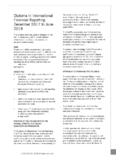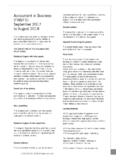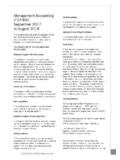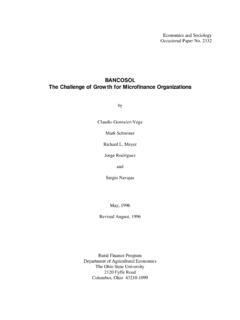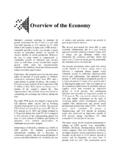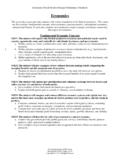Transcription of Ready for Growth? A checklist for CFOs of high-potential ...
1 Ready for growth ? a checklist for cfos of high-potential businesses About ACCAACCA (the Association of Chartered Certified Accountants) is the global body for professional accountants. It offers business-relevant, first-choice qualifications to people of application, ability and ambition around the world who seek a rewarding career in accountancy, finance and management. ACCA supports its 178,000 members and 455,000 students in 181 countries, helping them to develop successful careers in accounting and business, with the skills required by employers. ACCA works through a network of 92 offices and centres and more than 7,110 Approved Employers worldwide, who provide high standards of employee learning and development. Through its public interest remit, ACCA promotes appropriate regulation of accounting and conducts relevant research to ensure accountancy continues to grow in reputation and in 1904, ACCA has consistently held unique core values: opportunity, diversity, innovation, integrity and accountability.
2 It believes that accountants bring value to economies in all stages of development and seek to develop capacity in the profession and encourage the adoption of global standards. ACCA s core values are aligned to the needs of employers in all sectors and it ensures that through its range of qualifications, it prepares accountants for business. ACCA seeks to open up the profession to people of all backgrounds and remove artificial barriers, innovating its qualifications and delivery to meet the diverse needs of trainee professionals and their employers. More information is here: The Association of Chartered Certified AccountantsAugust 2015 This report examines the finance function of high- growth businesses and how this has evolved, providing practical guidance to high-potential businesses on how to harness the full potential of the finance report examines the finance function of high- growth businesses and how this has evolved alongside the growth of such businesses.
3 The report also provides practical guidance to high-potential businesses forecasting or entering high- growth stages on how to harness the full potential of the finance function, seeing this not only as a support and processing function but as a potential key business partner, informing strategic and operational aspects. The research for this report was drawn from ACCA s longstanding expertise in the remit of the finance function in high-potential businesses, as well as from eight in-depth case studies of businesses that have experienced periods of high growth . The key aspects that were explored were: characteristics of the finance function in high- growth businesses events in the lifetime of the business that prompted the founder/directors to build in additional financial capability the symbiosis between a company s high growth and its finance function how business planning works in a high- growth environment and the role of the finance team in this the particular skill sets and support required for senior management and the finance function in responding to and managing growth , and the challenges presented by both obstacles to growth and growing pains.
4 The chapters that follow examine each of these in turn, providing guidance and recommendations to high-potential businesses as to how best to tailor and adapt their finance function to help their company grow, and manage high growth when it eight case studies were constructed following in-depth telephone interviews with the CFOs and financial controllers of eight businesses worldwide that had experienced periods of high growth . These were drawn partly from ACCA s Global Economic Conditions Survey (GECS), filtered by the question asking businesses whether they had experienced high growth . For the purposes of this research, high growth was defined as over 70% growth during a period of three consecutive years (a derivative of the OECD definition of high- growth firms). Participants were also sourced via ACCA s network of national offices.
5 Although this report has integrated the learning emerging from all the high- growth businesses studied, some of these could not be showcased owing to commercial sensitivity, and so have been anonymised. The remainder are presented as case studies throughout this guide. PARTICIPATING HIGH- growth BUSINESSESThe eight participating businesses manufacture products and provide a broad range of services in international as well as domestic markets, being based in Taiwan, China, Vietnam, the US, Trinidad and Tobago, and China. The sectors in which they operate include communications and technology, real estate, education, logistics and supply chain services, construction, and green environmental technology. Their business models are largely service based, although some also had significant manufacturing activities, and most had diversified income streams related to the original sector in which they had been founded.
6 Examples of the products and services they offer include: internet and application services, recruiting students in local markets for overseas educational institutions, construction projects such as hotels and car parks, development of real estate, designing sensor technology, building wind turbines, and providing procurement services in retail, health care and agriculture supply of these high- growth businesses are Asia-based subsidiaries of larger holding companies, located mainly in Europe, while one had been created following the merging of several companies. The majority operate across international markets, especially Asia, the US and Europe, with a few having numerous offices located across continents, although most work from one office and are driven by smaller projects. Most were founded between 40 and 20 years ago (the 1970s through to the 1990s), with a minority being founded in the 2000s.
7 Their employee numbers ranged from 40 to 1000, and turnovers ranging from $5million to $2bn. Most were founded by family members setting up the business together, and continue to be family owned (including those owned by holding companies), with a minority having opened up to external most cases their finance functions had evolved significantly alongside the growth , diversification and internal changes/restructuring of the business, and their role and strategic importance had changed since the early stages of the business. IntroductionBackground to the report This guide was written with a two-fold function: to examine real-life examples of how the finance function in high- growth businesses has evolved, using eight case studies, and taking key learning from them to translate that learning into useful points of consideration and guidance that high-potential businesses, both SMEs and larger companies, can implement in harnessing the full potential of their own finance term finance function in ACCA s usage refers to the broader application of this function within a business, shifting from purely being a book keeping and processing service to a role more akin to that of a business adviser and, indeed, a key partner to the business as a whole.
8 The case study companies conceptual understandings of the finance function were found to vary with the different stages of their life cycles. In most cases, the finance function initially fulfilled its traditional accounting role and its basic processes, but over time it evolved to play a more strategic role as each business grew and diversified. This evolution varied between the companies, in some cases occurring organically as a reaction to high growth , and in others being planned and directed in anticipation of growth , indicating that there is no one-size-fits-all way in which the finance function can be understood and has adapted over time this very much depends on the nature of the business, and the way in which the remit of the business itself evolves and diversifies over time.
9 The case study businesses trajectories underscore the vital role of the CFO and, in particular, that this role can best be harnessed to its full potential if other teams across the company recognise its value, and are educated in integrating aspects of the finance function into their day-to-day work. At some point in their lifecycle, all the businesses featured in this guide demonstrated the innovative turn involved in high growth , driven by strategic internal decisions to enter new markets, acquiring technical expertise that enabled the development of new products, or responding directly to external stimuli such as consumer demand for new technologies. Often, this expansion entailed diversifying into new products and/or services, which carried with it certain risks. These included insufficient staff capacity to respond to new workloads; increased processes and business traffic such as simultaneous deals; entering new, very competitive and/or politically unstable markets; and being very reactive operationally, meaning that processes were not as smooth as previously.
10 Key lessons for mitigating these risks and managing high growth included investing in new talent to meet the challenges of the new markets and diversified business streams; implementing new methodologies for managing change proactively; closely monitoring growth and developing robust systems of control to ensure that it did not spiral beyond the company s capacity; and harnessing the capacity of the finance function not only to manage cash flows and create a safety net to boost the business s reserves, but also to analyse and plan future trends to maintain case studies demonstrate a clear symbiosis between business growth and the evolution of the finance function. The remit of the latter was almost always found to extend beyond operational tasks and processes during and especially after periods of high growth , often becoming a strategic business partner in itself driving this growth .
